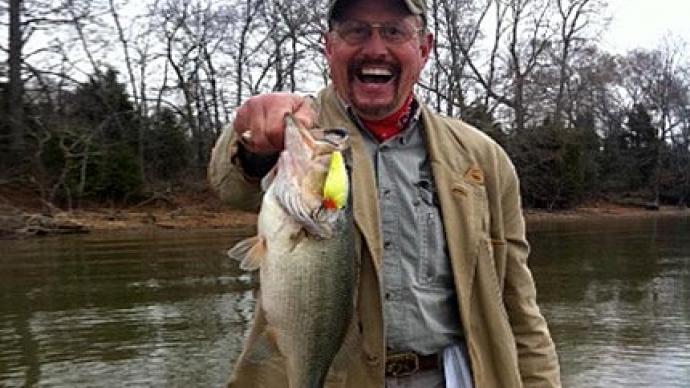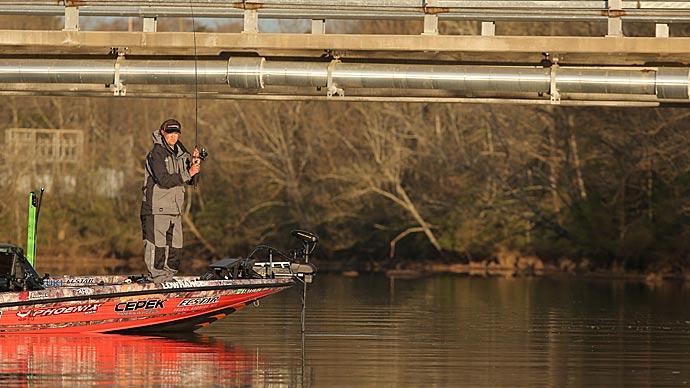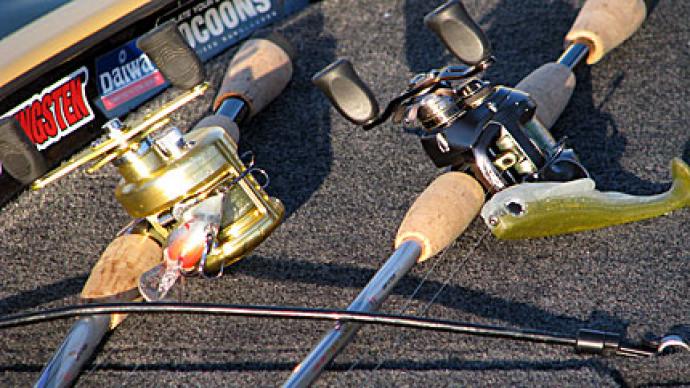
This is one of the most fundamental concepts of bass fishing. Bass and cover are similar to peanut butter and jelly. It's like the chicken and the egg. They go together. The bass is a creature of prey. He uses cover as a point of ambush to attack. The cover also protects other species.
Cover can be obvious, like stumps, laydowns, docks, vegetation. Or it can be subtle, like the change of two types of rock, deposits of bottom siltation on a sand bottom, or even shade. Cover is some physical object separate from the actual bottom contour. It is often mistaken for structure. Structure is the actual bottom contour (breaks, drops, humps, etc.).
As a general rule, the more extreme the conditions (heavy current, bad cold front, super hot water, really muddy water), the tighter too, and into cover, bass will be. The more stable the conditions, the looser a bass will relate to cover.
I. MULTIPLE PRESENTATIONS TO COVER
Whether you're crankbait fishing, jig fishing, or spinnerbaits, it's key to present multiple angles to the fish. I always like to start with the outside of the cover as a general rule first. This cast will be less likely to snag and may first catch the very active bass. After outside casting, I will probe deeper into the cover. I feel this presentation helps me maximize the amount of fish I might be able to catch from a particular piece of cover.
II. UNIQUE COVER PRESENTATIONS
A. THICK MATTED GRASS - the tunnel effect. This occurs when vegetation mats together. It is most often seen about vegetation such as hydrilla and milfoil. The obvious targets are the outside or inside edges or bringing a weedless bait over the top. The tunnel effect means that a series of tunnels and canals lies at the bottom of this matted vegetation by taking an extra heavy lure, such as a 3/4- or 1-ounce jig or plastic craw.
It is often the case that you will only be able to achieve that initial fall, but that is enough. The flipping technique caters to tunnel fishing. You don't have to worry about the silent entry most of the time. Sometimes letting the bait crash down will help penetrate the mat.
B. WAY UNDER DOCKS - Skip-Pitching technique. The skip-pitch combines the traditional pitch with a sidearm cast to enable flat-surfaced lures, such as the Stone Jig, to skip way back under cover. In this presentation, you want to hit the water's surface a few feet before your target. This allows the bait to gain momentum while skipping on the water's surface. The unique thing about the skip-pitch is that it's done with heavy line and conventional equipment. This allows you to fish in nasty stuff and have the power to bring out big bass.
C. BUMP THE STUMP - multiple angles are critical. This technique is super with both crankbaits and spinnerbaits. Every time your lure is deflected off a cover piece at a different angle, the lure will create a distinct movement. Often it takes the perfect movement to trigger an inactive bass into a reaction strike. By circling a cover piece, you can usually hit it from 4 or 5 different angles.




